 Image search results - "sign" Image search results - "sign" |
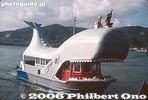
Boat to Rabbit and Monkey islands (no longer in service)
|
|

No Photography撮影禁止 - The sign reads "Satsuei kinshi." "Satsuei" means to take photos, and "kinshi" means "prohibited." The "No photo" symbol also makes it clear.
On Japanese warning signs, the three most common words you will see are "kinshi" (禁止), "kiken" (危険), and "chui" (or "go-chui") (注意). They respectively mean "prohibited," "danger," and "beware of."
Place: World PC Expo in Makuhari Messe in Chiba.
|
|

Air Nippon YS-11 propeller plane. Donated by All Nippon Airways in 1997.
|
|

Destination: Waseda
|
|

Front of YS-11 propeller plane.
|
|

No Photography撮影禁止 - Another sign that reads (top to bottom) "Satsuei kinshi." "Satsuei" means to take photos, and "kinshi" means prohibited. At this Shinto shrine, you are not allowed to photograph inside the main shrine building housing the altar.
Place: A shrine in Kyoto.
|
|

No Tripods三脚使用禁止 - The bold characters read, "Sankyaku shiyō kinshi" meaning tripod use is prohibited. The sign further explains that since tripods hinder the view of other spectators, they are not allowed except in the press photographers' box.
The kanji characters for tripod consists of "san" for three (the 3 horizontal lines make it obvious), and "kyaku" which means legs.
Place: Tsurugaoka Hachiman Shrine (during the Yabusame Festival), Kamakura, Kanagawa Pref.
|
|

No Tripods and Monopods, unless...三脚 一脚 - This sign says "Sankyaku, ikkyaku go-shiyō no kata wa, kyokasho (2,000 yen) ga hitsuyō desu." Since you learned the characters for "tripod" in the preceding image, you should also know the characters for monopod, called "ikkyaku," literally "one leg."
This sign is a warning and a money-making scheme. It says that you cannot use a tripod or monopod in this garden unless you pay 2,000 yen to obtain a permission slip.
Place: Heian Shrine Garden, Kyoto.
|
|

Toden streetcar leaving Oji Station
|
|
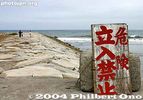
Danger, Keep Out危険 立入禁止 - The kanji characters on the right say "kiken" meaning danger. The big characters on the left say "tachi-iri kinshi" meaning "entry prohibited." Remember the word "kiken" (危険). It is one of the three most common words on warning signs in Japan. Another one is "kinshi" (禁止). If you see it, be aware that something is prohibited.
Place: Ohara beach, Chiba.
|
|

Do not Enter立入禁止 - Another "entry prohibited" sign or "tachi-iri kinshi" in red kanji characters. On the right, the characters read, "kankei-sha igai" meaning "unauthorized persons."
Place: Lake Biwa at Otsu, Shiga Pref.
|
|
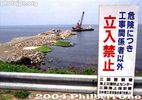
Do Not EnterThis sign is similar to the preceding one. The middle column of characters has the word "kōji" (工事) which means construction. So the sign means, "Danger: No entry except for authorized construction workers."
Place: Mikuni-cho, Fukui Pref.
|
|
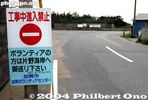
Under Construction - Do Not Enter工事中 - Another variation of "Do not Enter." The red characters read "Kōji-chū shinnyū kinshi" meaning no entry during construction operations. The "No entry" traffic symbol is also a tell-tale sign. You usually see this symbol at the entrance of a one-way road (if you face the wrong direction).
|
|
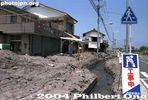
Under Construction工事中 - The sign reads "Kōji-chū" meaning "under construction." You see this often at Japanese Web sites as well.
Place: Near Mt. Fugendake, Nagasaki Pref. (Note that the year stated in the image indicates the year the photo was first published, not the year when the picture was taken.)
|
|

Go Slow徐行 - The sign on the right says "Jokō" meaning go slow (when boarding or disembarking from the ferry). You may see this at construction sites as well.
Place: Onomichi, Hiroshima Pref.
|
|

Danger! Do not Jump in River危険!川へ飛び込まないでください。- The red characters read "Kiken!" (Danger!), and the black characters say "Kawa e tobi komanaide kudasai." "Kawa" is river, "tobi komi" is to jump or dive in.
This at the famous Dotonbori canal in central Osaka where it is a popular place for fanatical baseball fans to jump in whenever the local baseball team (Hanshin Tigers) wins big. The river is quite polluted and littered with trash (though recently cleaned up by the city). During the Soccer World Cup in 2002, several hundred people jumped in the water when the Japan team won a crucial game.
Place: Dotonbori, Osaka.
|
|

Nissan Pivo with swivel topElectric car with a top that swivels 360˚ so you can drive forward or back without turning the car around. Seats three people. The driver sits in the middle.
I waved to her, and she waved back...
|
|

No Swimming遊泳禁止 - By now you must be getting sick of seeing this word "kinshi." Well, it's certainly not a pleasant word since it limits your freedom. But it also serves to keep you safe. The kanji in red reads "yūei kinshi" meaning "swimming (and playing in the water) prohibited." Below in black reads, "Koko wa suieijō dewa arimasen." This is not a place for swimming.
Place: Lake Biwa at Otsu, Shiga Pref.
|
|
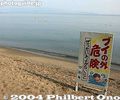
Do not Go Beyond the Buoysブイの外 危険 - It reads "Bui no soto kiken" which means "Dangerous to go beyond the buoy." The buoys in this case are the brightly-colored floating balls that mark the outer boundary of the safe swimming area. The water is usually too deep or the waves are too dangerous beyond this boundary. Almost all swimming beaches in Japan have some kind of outer boundary.
Place: Northern Lake Biwa, Shiga Pref.
|
|
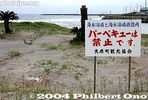
No BBQバーベキューは禁止です - The characters in red say, "barbecue wa kinshi desu." Having a barbecue is prohibited.
Place: Ohara beach, Chiba Pref.
|
|

Take Off Your Shoes土足厳禁 - It says "Dosoku genkin" or footware prohibited. "Dosoku" literally means dirty feet, and "genkin" is like "kinshi," meaning prohibited. So we have to take off our footwear before going up the stairs to see the second floor of this museum.
In most places, it will be obvious that you have to take off your shoes before entering the castle, museum, temple, etc. At the entrance hall, you will see a shelf to store shoes and indoor slippers lined up on the floor.
Place: Azuchi, Shiga Pref.
|
|
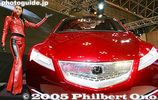
Honda Sports 4 ConceptI like this picture.
|
|
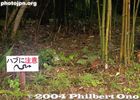
Beware of Habu Snakesハブに注意 - "Habu ni chūi." Finally we see the third most common word on warning signs: Chui, meaning "beware of" or "watch out for." Habu is a species of poisonous snake common in Okinawa where this picture was taken.
Place: Okinawa
|
|
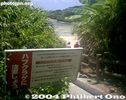
Beware of Jellyfishハブクラゲに注意しよう! - "Habu kurage ni chūi shiyō." Beware of jellyfish. In Okinawa, "habu kurage" (Chiropsalmus quadrigatus) is a type of poisonous jellyfish whose venomous sting can cause death.
Place: Taketomi island, Okinawa.
|
|

Beware of Wild Monkeys野生の猿にご注意 - "Yasei no saru ni go-chūi." "Yasei" means wild, and "saru" is monkey. Japan has a substantial population of wild monkeys which can be very aggressive in foraging for food, especially at tourist spots. They often steal food (sweets, etc.) from tourist shops and commonly grab any paper or plastic bag that you are carrying. If you see wild monkeys, you should not feed them nor carry any bags with your hands.
The sign also says "We cannot be responsible for any accidents caused by wild monkeys."
Place: Mt. Hiei Driveway, Kyoto.
|
|
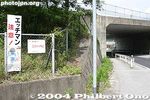
Beware of Flashers!エッチマン注意! - Besides watching out for poisonous snakes, jellyfish, and wild monkeys as you saw in the previous images, there's one last wild animal to watch out for: the flasher. Apparently, this country neighborhood has had a flasher (a person who shows his genitals) so often that they put up this sign to warn female passers by.
The sign reads "H man chūi!" "H" is for "hentai" meaning pervert. "Man" is man, and you know what "chūi" means.
Place: Country road, northern Shiga Pref.
|
|
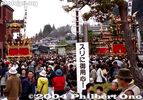
Watch Out for Pickpockets!スリに御用心 - Another human animal to watch out for. "Suri ni go-yōjin!" means watch out for pickpockets! "Suri" means pickpocket, and "go-yōjin" is like "chūi."
Place: Takayama Festival, Gifu Pref.
|
|
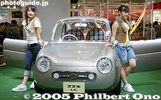
Suzuki LC. LC stands for Life Creator. These girls were dancing and hopping around the car before they settled down and posed.
|
|
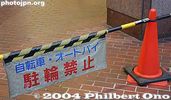
No Bicycle/Motorcycle Parking駐輪禁止 - "Chūrin kinshi" in red characters mean two-wheeled vehicles cannot park here. In blue characters, it says "jitensha" (bicycles) and "ōtobai" (motorcycles and motor scooters).
Place: Street corner near a train station in Tokyo.
|
|

No Smoking on Street路上喫煙はやめましょう - This is "Rojō kitsuen wa yamemashō." It means please don't smoke while walking on the street.
Place: Street corner near a train station in Tokyo.
|
|
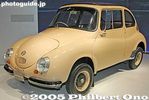
Subaru 360 (from 1958). Nicknamed "Ladybug."
|
|

Honda S600 (1964)The Event Hall had displays of nostalgic cars from the 1950s to the 1990s. This Honda was from 1964.
|
|
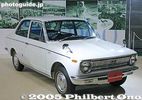
Toyota Corolla (1967)The Event Hall had displays of nostalgic cars from the 1950s to the 1990s.
|
|
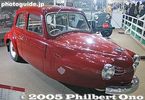
Daihatsu BEE (1951)The Event Hall had displays of nostalgic cars from the 1950s to the 1990s. Three wheels.
|
|
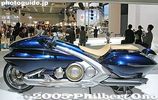
Yamaha Gen-Ryu motorcycle
|
|

Petite robot
|
|

He dances too.
|
|

Humanoid hand of ASIMO.
|
|
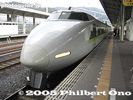
Shin-Iwakuni Station
|
|

Robot dog
|
|

Sign in English, Chinese, Korean, and Russian.
|
|

New Chitose Airport, Hokkaido's main gateway, is the first place you see G8 Hokkaido Toyako Summit Welcome signs as we get off the plane.
|
|

New Chitose Airport, another Welcome sign as we head for the baggage claim area.
|
|

New Chitose Airport, another Welcome sign as we head for the baggage claim area.
|
|

Inside New Chitose Airport's Central Plaza, more G8 Hokkaido Toyako Summit Welcome signs.
|
|

Inside New Chitose Airport's Central Plaza, more G8 Hokkaido Toyako Summit Welcome signs.
|
|

New Chitose Airport's Central Plaza
|
|

New Chitose Airport's beautiful Central Plaza.
|
|

New Chitose Airport's Central Plaza
|
|

New Chitose Airport's Central Plaza
|
|

Inside New Chitose Airport's Central Plaza, G8 Hokkaido Toyako Summit countdown.
|
|

Inside New Chitose Airport at the check-in terminal, more G8 Hokkaido Toyako Summit Welcome signs.
|
|

On the boarding bridge to the plane. Notice the G8 Hokkaido Toyako Summit Welcome signs.
|
|
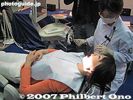
Dental students can practice on this robot which will say "ouch" if you do something wrong. If your elbow accidentally touches the robot's breast, it will also yelp. Also see my video
|
|
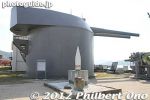
The Gun turret was a part of the main gunnery system of Battleship Mutsu and was transferred to Imperial Naval Academy for use as a study aide in 1935.
|
|
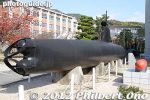
One of the five midget submarines used in the Pearl Harbor attack. On display at the Naval History Museum on Etajima island, Hiroshima.
|
|
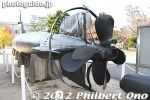
They eventually found all five subs (the fifth one was finally found in 2009) used at Pearl Harbor. Two of them are on display. One of them is here and the other is at the National Museum of the Pacific War in Fredericksburg, Texas.
|
|
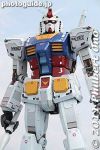
Giant Gundam with eyes aglow at Shizuoka Hobby Fair 2010-2011.
|
|
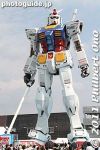
He turns his head back.
|
|

Electrical appliances from the 1950s-70s.
|
|

Even the trains have a ninja (female) paint job.
|
|

Ninja paint job on a train.
|
|

What would a ninja museum be without a display of shuriken?
|
|
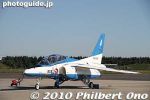
Blue Impulse jet
|
|
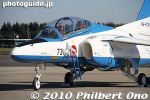
More photos of the Blue Impulse later on below.
|
|
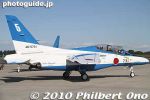
Blue Impulse Kawasaki T-4
|
|
|
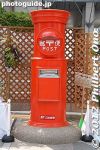
Japan's largest round mailbox in Kodaira, Tokyo is 2.8 meters tall and weighs 1.5 tons (without mail). Tokyo's 23 wards has only 5 of these old, round mailboxes in use.
|
|
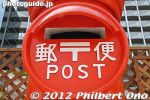
You don't have to reach here to put in your mail.
|
|
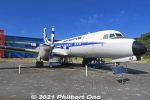
YS-11A, Japan's first passenger plane built after World War II. In service from the 1960s to 1995. Displayed at Gifu-Kakamigahara Air and Space Museum.
|
|
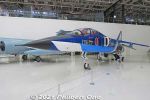
Mitsubishi T-2 Blue Impulse aerobatic jet. T-2高等練習機
|
|
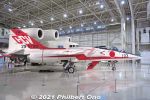
Mitsubishi T-2 Control-Configured Vehicle (CCV) from 1972. Research jet. T-2CCV研究機
|
|

NAL Asuka STOL Research Aircraft (National Aerospace Laboratory) flew during 1986–1989. 低騒音STOL実験機「飛鳥」
|
|
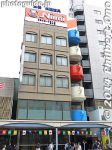
Stairway with cups.
|
|
|

100 series shinkansen, 2nd generation with the slit headlights and pointy look.
|
|

Red pay phone was very common in Japan, now virtually extinct.
|
|
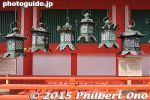
Kasuga Taisha Shrine is also noted for many bronze hanging lanterns.
|
|
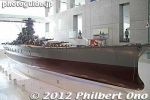
The scale model of the battleship is 26.3 meters long. It has been reconstructed as accurately as possible based on photographs and exploration of the wreck.
|
|
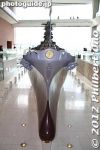
Battleship Yamato has an Imperial chrysanthemum crest on the bow. This was one of the things which helped to identify the wreck on the sea bottom.
|
|
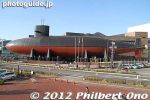
The JMSDF (Japan Maritime Self-Defense Force) Kure Museum is mainly a submarine museum whose main attraction is the decommissioned Japanese sub called Akishio. The museum is conveniently right across the street from the Yamato Museum.
|
|
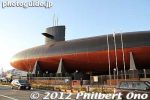
The former Akishio submarine just stands out and can be seen from boats approaching Kure Port. Very impressive to be seen on land amid small cars passing by. The museum is a short walk from JR Kure Station.
|
|
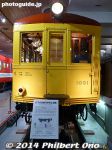
The exterior livery of the newest Ginza Line subway cars is based on this first subway car.
|
|
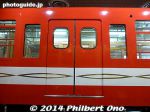
Marunouchi Line subway car
|
|
|
|

Misspelled word (Prirate).
|
|
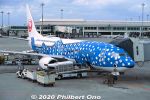
Japan Transocean Air (JTA) Boeing 737-800 plane painted like a whale shark (blue). ジンベエ ジェットNot my plane back to Haneda though. This video shows how they painted the plane: https://youtu.be/MbrK-8Bkjx0
|
|

Pink whale shark Japan Transocean Air (JTA) Boeing 737-800 at Naha Airport. Very eye-catching.
|
|

JR–Maglev MLX01-1
|
|

Class 955 "300X" experimental Shinkansen
|
|

Nozomi 700 Series Shinkansen. "Duckbill" design.
|
|

100 Series Shinkansen (2nd generation). I call this the "Slit-eye" model.
|
|

The classic and iconic "Bullet Train." The original shinkansen model that debut in 1964, the 0 Series Shinkansen (1st generation). Classic and iconic design.
|
|

One unique thing about the 100 Series Shinkansen was this two-story car with a restaurant on the upper level.
|
|

Tokkyu Limited Express train, 381 series
|
|
|

Japanese Government railway's first bus.
|
|
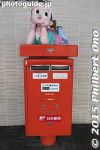
Momotaro Peach Boy on a mailbox.
|
|
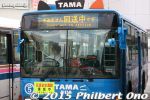
"Sorry, not in service." What a polite bus in Okayama! Even in Japanese, it actually apologizes for not being in service. Also notice the cat ears on the roof, the painted whiskers, and the nickname "Tama Bus."Nicknamed after a stray cat named Nitama that was found in Okayama and adopted as the stationmaster of Idakiso Station in Wakayama. The original and nationally famous cat stationmaster named Tama at Kishi Station on the same train line died earlier this year. So Nitama took over. So happens that the train line's parent co. is the same as this bus company's based in Okayama.
|
|

Tohoku shinkansen, 200 Series Shinkansen
|
|

Tohoku shinkansen's snow sweeper.
|
|

All shinkansen stations had platform chairs having the same color theme of blue and cream.
|
|

Inside Class Oha 31 train car. Japan's first semi-metal train car for improved strength. Wooden interior. Notice the heater.
|
|

TR73 series first-class car targeting foreign tourists.
|
|

Ferry from Rishiri to Wakkanai. Souya Maru No. 5 第五宗谷丸
|
|

Old telephone still widely used in Japan until the 1980s.
|
|
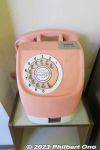
Pink pay phone in Japan. Now obsolete. Took only ¥10 coins.
|
|
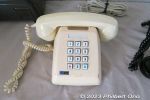
Push button phone widely used in Japan until the early 1990s.
|
|

New Chitose Airport, Hokkaido's main gateway, is the first place you see G8 Hokkaido Toyako Summit welcome signs. As we get off (or get on) the plane.
|
|

New Chitose Airport, another welcome sign as we head for the baggage claim area.
|
|

New Chitose Airport, another welcome sign as we head for the baggage claim area.
|
|

Inside New Chitose Airport at the check-in terminal, more G8 Hokkaido Toyako Summit welcome signs.
|
|

Inside New Chitose Airport's Central Plaza, more G8 Hokkaido Toyako Summit welcome signs.
|
|

Inside New Chitose Airport's Central Plaza, more G8 Hokkaido Toyako Summit welcome signs.
|
|

Inside New Chitose Airport's Central Plaza, G8 Hokkaido Toyako Summit countdown.
|
|

The train to Lake Toya is also decorated with G8 Hokkaido Toyako Summit welcome sign.
|
|
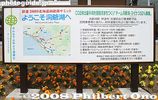
Welcome sign in front of JR Toya Station, the closest train station to Lake Toya.
|
|

Ticket office inside JR Toya Station. Notice the G8 Summit flags.
|
|

Ticket office inside JR Toya Station with G8 Hokkaido Toyako Summit flags.
|
|

Glass door with G8 Hokkaido Toyako Summit welcome sticker.
|
|

Next to Toya Station is the Toyako Town Hall, also with a G8 Hokkaido Toyako Summit welcome sign.
|
|

Toyako Town Hall, front side, festooned with G8 Summit flags.
|
|

Toyako Onsen Spa tourist information office with a G8 Hokkaido Toyako Summit welcome sign.
|
|

On the shore of Lake Toya is binoculars through which you can see the Summit venue, the Windsor Hotel.
|
|

The Windsor Hotel, G8 Hokkaido Toyako Summit venue is on a hill overlooking the lake. Below is a lake cruise boat.
|
|
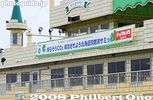
The lake cruise boat with G8 Hokkaido Toyako Summit welcome sign.
|
|

G8 Hokkaido Toyako Summit welcome sign on the edge of Toyako Onsen hot spring.
|
|

Toyako Visitors Center and Volcano Science Museum in Toyako Onsen Spa.
|
|

G8 Hokkaido Toyako Summit countdown at Toyako Visitors Center and Volcano Science Museum in Toyako Onsen Spa.
|
|

Official logo of the G8 Hokkaido Toyako Summit on the Toyako Culture Center.
|
|

Toyako Culture Center with G8 Summit flags.
|
|

G8 Hokkaido Toyako Summit welcome sign on entrance of Toya Mizunoeki, a shopping and rest house in northern Lake Toya.
|
|

G8 Hokkaido Toyako Summit welcome sign on window of Toya Mizunoeki in northern Lake Toya.
|
|

Personal computers for public use inside Toya Mizunoeki in northern Lake Toya. Notice the G8 Summit flags.
|
|

G8 Hokkaido Toyako Summit welcome banner at a gas station in northern Lake Toya.
|
|

G8 Hokkaido Toyako Summit welcome sign at Mt. Showa-Shinzan.
|
|

G8 Hokkaido Toyako Summit welcome sign at Usuzan Ropeway terminal.
|
|

G8 Hokkaido Toyako Summit welcome sign at Usuzan Ropeway terminal.
|
|

The Usuzan Ropeway terminal has gift shops selling a variety of G8 Hokkaido Toyako Summit merchandise. T-shirts, bags, candy, etc.
|
|

This box of cookies show all the G8 Summit leaders bathing in a hot spring and scrubbing each other's backs. They also say, "Ii yu!" (great hot spring) which is pronounced "EU" as a pun.
|
|
|
|

Sobetsu Town Hall with a G8 Hokkaido Toyako Summit welcome sign. Sobetsu fronts the east shore of Lake Toya.
|
|

G8 Hokkaido Toyako Summit welcome sign in Sobetsu.
|
|

G8 Hokkaido Toyako Summit welcome poster.
|
|

G8 Hokkaido Toyako Summit welcome poster.
|
|

G8 Hokkaido Toyako Summit welcome poster.
|
|

Environmental poster.
|
|

G8 Hokkaido Toyako Summit merchandise: Key chains for all the G8 Summit countries.
|
|

G8 Hokkaido Toyako Summit merchandise: Pins
|
|

G8 Hokkaido Toyako Summit merchandise: T-shirts
|
|

G8 Hokkaido Toyako Summit merchandise: Eco-bag
|
|

G8 Hokkaido Toyako Summit merchandise: Manju
|
|

G8 Hokkaido Toyako Summit merchandise: Confections sold at the train station kiosk
|
|

G8 Hokkaido Toyako Summit confection
|
|

G8 Hokkaido Toyako Summit potato confection.
|
|

G8 Hokkaido Toyako Summit countdown in front of Sapporo Station.
|
|

G8 Hokkaido Toyako Summit countdown at the former Hokkaido Government Building.
|
|

G8 Hokkaido Toyako Summit sign inside the former Hokkaido Government Building.
|
|

G8 Hokkaido Toyako Summit Welcome banner on a building in Sapporo.
|
|

G8 Hokkaido Toyako Summit welcome sticker on a bus window in Sapporo.
|
|

G8 Hokkaido Toyako Summit welcome sticker on a bus window in Sapporo.
|
|
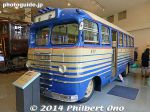
Another highlight is this beautiful, classic Tobu bus from 1951. Cab-over type bus displayed at Tobu Museum in Sumida Ward, Tokyo.
|
|
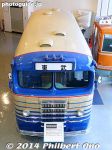
This bus was made by Nissan in 1951.
|
|
|
|
|
|
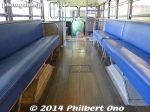
Wooden floor.
|
|
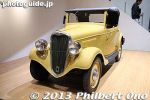
Classic Nissan
|
|
|
|
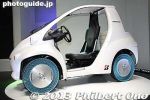
Airless tires
|
|
|
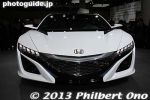
Honda
|
|
|
|
|
|
|
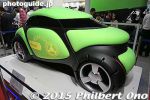
Cushioned car
|
|
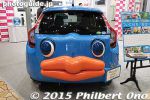
Car with lips
|
|

Love Toyooka's bag bus.
|
|

Toyooka in Hyogo Prefecture is a major producer of bags. Thier local bus even has a bag design.
|
|

Toyooka's bag bus.
|
|

The festival was not only about Toyota. They also had classic cars from different makers, even Nissan. 1962 Toyopet Crown
|
|

1967 Toyopet (Toyota) Corona Hardtop 1500S
|
|
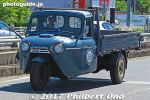
Three-wheeler, Mazda T2000 from 1967.
|
|

Mazda Cosmo
|
|
|

Toyoda Model AA replica, Toyota's first passenger car from 1936.
|
|
|
|
|
|

240Z (Nissan Fairlady Z), 1970.
|
|

Lexus LFA from 2009. Toyota's first super car. Only 500 were sold.
|
|

Toyota 2000GT from 1967. The museum is celebrating this car's 50th anniversary. So they have a few of these on display in 2017.Made famous by James Bond in "You Only Live Twice." But the film featured a custom-made convertible instead (only two convertibles were made, both for the film). Design was inspired by the Jaguar.
|
|

Fire engine
|
|

Daihatsu Midget Model MP5, 1963. Love these three-wheelers.
|
|
|
|
|